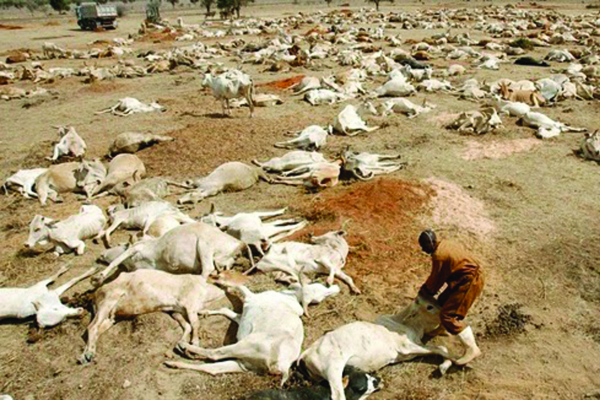
DOMBOSHAVA — The future and sustainability of the cattle dung manure-fed biogas digesters hangs in the balance following widespread deaths of cattle in Goromonzi district under mysterious circumstances.
BY TONDERAYI MATONHO
The community in Ward four is still puzzled by the situation, particularly, when the responsible ministry for livestock development, has failed to come up with an explanation.
Cornelius Chataika, the treasurer of the Domboshava Development Community Association (DDCA), said “about 90% of the cattle around the ward, died due to an unknown air borne disease and this had affected the availability of cow dung to feed the digesters”.
“The future and sustainability of the biogas digester projects in this ward and other surrounding areas is now threatened with the deaths of hundreds of cattle in 2017 with experts in the livestock ministry even failing to explain the mysterious disease,” he said.
“The situation was so severe and what we only observed during this period after the deaths were blisters around the livers of the cattle.”
This information was disclosed during a recent field visit organised by ZERO, a regional non-governmental organisation, to delegates from the civil society organisations and government ministries, the private sector and representatives from the Domboshava community.
Meanwhile, an official from the Energy and Power Development Ministry, Chido Mado, said during the field visit, “lack of constant feeding of digesters leads to the development of ‘scum’, a thick dirty foam layer on the surface of the liquid manure and this will require a complete renovation of the plant for effective biogas production”.
- Chamisa under fire over US$120K donation
- Mavhunga puts DeMbare into Chibuku quarterfinals
- Pension funds bet on Cabora Bassa oilfields
- Councils defy govt fire tender directive
Keep Reading
“In order to counter that, it is better to provide minimal feed to the plant than completely desist from feeding”, Mado said, equating biogas digesters to the human body which requires everyday feeding for its survival.
On the issue of packaging gas into containers for sale, she noted that “this was expensive” and the best solution was to connect neighbours at village level to the bio digesters, so that one can earn some income from selling the gas.
A trust was formed after the realisation that there was no longer enough fuel wood from the remaining forests due to massive deforestation and degradation in the Mungate community, which forms part of Ward Four. There was need to look for alternative solution to the energy crisis.
To date, the trust has constructed 31 biogas digesters in this community, with 14 constructed through monthly contributions by the community. The American Embassy then donated $9 800 in 2014, to speed up construction of biogas digesters for the members of the trust.
“Of the 31 bio digesters constructed, only two are 10 cubic metres and the rest are 5 cubic metres, installed at a cost of $800 each with a 50-year guarantee,” Chataika said, adding that the five cubic metre one produces enough energy for a family of eight while having three meals a day.
Barbra Warikandwa, a bio digester beneficiary, said that her family uses cow dung, vegetable waste and chicken waste to feed their 10 cubic metre bio-digester plant.
“Even though our plant has not received feed for the past year due to the cattle deaths, it is still producing enough energy for cooking, with household costs getting lower ever since we started to use biogas for cooking,” said Warikandwa.
She also noted that as farmers, their horticulture business has boomed because the slurry from the plant is used as fertilizer for horticultural plants. Warikandwa is currently supplying horticultural produce to supermarkets such as TM, OK and Spar and was also supplier of the year in 2017 at TM/Pick and Pay at the main Borrowdale Shopping Centre. “The project has relieved women and children of traditional chores that have tended to keep women disadvantaged and is also allowing children to attend school more often and participate in other social activities rather than looking for firewood”, she said.
Gamuchirai Chipangura, a programme officer at the Zimbabwe Women Resource Centre and Network, said there was need to seriously involve and broaden issues of women, widows and child-headed households, as this was critical in the progress of such bio digester projects as these vulnerable groups now dominate many rural communities.
“There is a lack of consideration of complete participation of vulnerable groups in many such community development projects. Many of these vulnerable groups are not well represented and are not benefitting from such projects,” she said on the sidelines of the recent field visit.
ZERO programme officer, Wellington Madumira, said: “Community involvement, local partnerships, smart solar and bio gas design with continued training, maintenance and renewable energy policy alignment are essential in meeting rural communities’ energy needs”.
The deputy director, research and technology, in the Higher and Tertiary Education ministry, Charles Musari, also noted that the food security and technology promotion equation needed to be seriously considered in such projects.
“We have a situation where cattle dump is required to be fed into bio digester plants and at the same time, the same material is required as manure in household crop fields and given this scenario the issue of sustainability of projects tends to be threatened, affecting household food security,” he observed.
The Ministry of Energy and Power Development in collaboration with SNV is working with communities in the biogas schemes for women in Mungate Village of Goromonzi District to achieve universal access to energy.
The overall work programme is expected to contribute towards the achievement of universal energy access for all by 2030 through decentralised and renewable energy options for poor rural and peri-urban communities.











